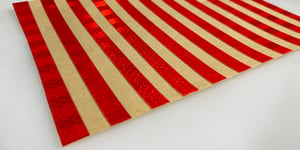Imagine you go to the store to buy a coffee mug, and the workers say they'll have to try forging one in a kiln first.
Jeez, you might think to yourself. Why should I pay you to test your production methods?
A trial can seem intimidating and unnecessary when you’ve already received laser or flash cut samples. Why have a trial at all? Using die cut trials, Strouse has helped transform thousands of adhesive parts from napkin drawings to successful products.
If your designs are complex enough to make you fret over manufacturability, this article is for you: Keep reading to figure out why you need a die cut adhesive trial.

4 Reasons You Need a Trial Before Ordering Die Cut Adhesives
A trial will determine whether your converter has adequate plans and tools to produce your part.
In the past, your converter might’ve sent laser or flash cut samples to test the materials or design. However, trial prototypes transition the production to a rotary, laser, or flatbed die cut press to test the setup and creation process.
Essentially, we are proving out assumptions made during the design phase. This is to ensure that your quote matches actual cost as best as possible. Because trials can be expensive, we’ve put together a list of four reasons trials are a crucial step of the converting process, the value of a trial, and the consequences of skipping it.
1. DIE CUT FEASIBILITY
Die cut feasibility is the likelihood of successfully building your part based on the design, materials, and specified tolerances.
When you ask Strouse to evaluate your die cut drawing, our first step is assigning your sketch to one of our engineers so we can get a better idea of its feasibility.
By examining your die cut’s tolerances, we’ll know how difficult it’ll be to build using your current design or chosen material. For instance, if you want to use challenging die cut material, we’ll likely recommend you participate in a trial.
Complex designs, challenging materials, and tight tolerances can increase your chances of needing a trial. Our engineers will create a plan to build your part and ultimately recommend a trial if it makes sense to check the feasibility.
2. CHECKING PART TOLERANCES
One of the most significant factors in deciding whether we suggest a trial is your die cut tolerances.
As previously mentioned, tolerances and materials go hand in hand because challenging materials make it harder to reach tight tolerances. Thick materials, like foam, curl inward as the blade sinks into them, which means we typically have to run them at slower speeds. However, running material on the press at a slower speed allows us benefits such as meeting tighter tolerances.
A trial allows your converter to refine the production process until the die cut tool slices through the material well enough to meet your ideal tolerances and create the parts you need.
3. PROOF OF PROCESS
Although Strouse has been converting adhesives for around four decades, many projects are still complex enough for us to want to do a proof of process. Every job we run is custom to our customer. While we may have seen something similar, we’ve never run this exact product before.
Proof of process involves building your prototype on a production die cutting press instead of sampling methods to represent the final process accurately.
Laser cutting samples can cause burnt edges or melt materials like foam or plastic which may not be acceptable in production. Meanwhile, flash cuts aren’t as precise and generate many tiny, jagged edges.
Rotary die cut trials create the part as it’ll be in your final product, which is necessary if your part has to undergo testing such as validation and verification.
4. VALIDATION AND VERIFICATION
Validation and verification are often required to confirm the legitimacy of medical products.
Part validation ensures the part fulfills its purpose throughout physical use, while medical professionals confirm part verification through tests or inspections.
A product needs prototypes of the actual parts it’ll be using to obtain valid validation and verification. Therefore, if the final product will be a rotary die cut, a rotary die cut trial is necessary before you can proceed with the validation and verification.
What Will Happen if I Don’t Get a Die Cut Trial?
Die cut production includes some level of trial and error to be addressed through a trial or your valuable project run time.
Skipping the die cut trial process might lead to non-functional parts, which we couldn’t even supply you with due to our own ISO standards.
Often, there are hundreds of tiny details to address before your project is ready for full-on production, such as adjusting the position of the die or calibrating the speed at which the material is running. Your converter needs to sort these details to ensure your parts are fully functional.
A die cut trial offers reassurance that the prototypes you receive are accurate to the final product and opens the door for any additional testing or validation and verification you need.
What Else Should I Know About Die Cut Trials?
You’ve read about how essential it is to have a die cut trial, but there’s one last aspect to review: die cut prototypes and samples.
If you’re not yet at the stage of running a trial but you still want to test your design, consider die cut samples. Die cut samples will allow you to try different materials and small changes in design:
On the other hand, if you’re ready for a trial, you might wonder how many prototypes you’ll receive. The number of parts that we get from a trial depends on the success or failure of the trial. We can’t guarantee we’ll get a certain amount, but we will try to get as many as we can.
For more information on die cut prototypes or the cost of a trial, you can contact us or learn more about the cost of a die cut today.
%20(1)-min.png?width=290&name=Untitled%20(52)%20(1)-min.png)






